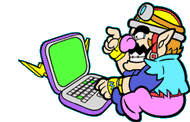WarioWare, Inc. Mega Microgame$! review
The Game Boy Advance is one of my favorite game systems of all time. When Nintendo released the GBA SP, I think they may have perfected the video game handheld. Sure, it really could have used four face buttons instead of two, and its screen was pretty darn dark (even when backlit), but the GBA provided some of my favorite gaming moments.
And no game embodies the GBA’s quirky sensibilities more than the playfully weird, shockingly innovative sideshow that is WarioWare, Inc. Mega Microgame$!.
Called “Made In Wario” (メイドインワリオ) in Japan, WarioWare presented players with an entirely new type of game: a massive collection of minigames, which are thrown at the player in rapid succession, the speed of each challenge increasing as the player advanced. The minigames were so extremely short—maybe only four seconds long at most?—that “mini” wasn’t even considered the proper term. These interactive vignettes were so bite-sized, Nintendo called them “microgames” instead.
The extreme brevity of each microgame is precisely where the addictive challenge of WarioWare lies. Even if players are familiar enough with each microgame so that they know what to do in every round, the game speed will eventually still exceed the point where the player can react in time.
The premise of WarioWare is that goofy old Wario has decided to get into video game development in his latest scheme to make tons of money. (Apparently nobody told him what a terrible get-rich-quick plan that is.) New to running a game company, Wario’s tiny games run the gamut from just normal weird to extreme wild-ass weird.
You have, of course, the usual Wario strangeness in keeping with the character’s offbeat style. But this game also included a brand new cast of original characters, many of them just as weird as Wario himself. These characters bring original personalities and their own collection of microgames, each one with their own particular theme. Jimmy T. has “Sports” games, Mona’s games are “Strange”, Dribble and Spitz have the “Sci-Fi” genre, and so on.
At the time of release, there was much excitement around the character 9-Volt and his collection of “Nintendo Classics”. These were clips of gameplay lifted directly from NES titles, older Nintendo arcade titles, and even older Nintendo-made toys, like the Ultra Hand. Along with Animal Crossing, this was one of the first times I remember seeing Nintendo truly indulging in nostalgia, celebrating the games of their dominant past.
After unlocking each of the microgame sets, WarioWare also includes unlockable minigames, complete with their own saved high scores, for a select few games. There is “Skating Board”, Paper Airplane, Pyoro and Pyoro 2, and of course, my personal favorite: Dr. Wario.
As a slightly altered port of Dr. Mario on the NES, Dr. Wario is a single-player only experience, but one of my favorite versions of the game. After clearing pieces in this game, you can hold Down to make the remaining MegaVitamins drop faster—a feature not included in any other versions of Dr. Mario, as far as I know. Being able to speed up the drop at all times is really great for an impatience player like myself. And since there is no competitive mode of Dr. Wario, its inclusion doesn’t have any unexpected side-effects.
It’s honestly pretty crazy to think about how fresh and innovative the first WarioWare was at the time of its release in 2003. It was followed by plenty of sequels and spin-offs, of course, with the GameCube title WarioWare, Inc.: Mega Party Games! being basically just a console-ized remake of that first GBA game—same microgame collection and everything. But as iterations on the WarioWare formula, nothing came close to the brazen originality of the first game.
So if you’re looking for the pinnacle of entertainment available on the Game Boy Advance, it’s really difficult to top WarioWare, Inc.








